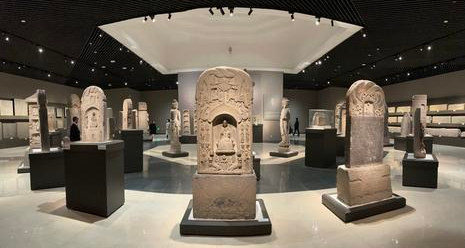Zhengzhou International 到河南博物院来 感受“会说话”的石刻

Henan Museum recently opened a permanent exhibition on the first floor of its main exhibition hall -- the Ancient Stone Carving Art Exhibition of Central China, which has added a new highlight to the museum.Those who are interested in it could go and have a preview.
近日,河南博物院在主展馆一楼新开放了一个常设展览——中原古代石刻艺术展,增加了一个新亮点,感兴趣的朋友赶快去先睹为快吧。

the Ancient Stone Carving Art Exhibition of Central China includes four parts: stone carvings of Han Dynasty portraits, tomb stone, epitaph and buddhist statue.
中原古代石刻艺术展共包括汉代画像石刻、陵墓石雕、墓志、佛教造像四个部分。

Stone carvings of Han Dynasty portraits are mostly decorative architectural components on stone que, stone room and mausoleum. Henan Han Dynasty stone carvings are mainly distributed in Nanyang, Shangqiu, Zhengzhou, Xuchang and Jun county, etc., with different contents and artistic styles.
汉代画像石刻,多为石阙、石室和陵墓上的装饰性建筑构件。河南汉代画像石主要分布在南阳、商丘、郑州、许昌和浚县等地,画像内容不同,艺术风格各异。

The stone carvings of the ancient tombs in Henan province were mostly used as a symbol of honor in front of the tombs of the ancient emperors and nobles. They were mainly composed of stone to ward off evil spirits, stone sheep, stone horses, stone lions, stone tian-lu, Stone weng-zhong and Shendao Pillars. They were solemn, powerful and magnificent, and were made from the Eastern Han Dynasty to the Ming and Qing Dynasties.
河南古代陵墓石雕多为古代帝王贵族墓前之仪仗,以石辟邪、石羊、石马、石狮、石天禄、石翁仲以及神道柱等为主,庄严肃穆,威武雄壮,时代自东汉至明清历代皆备。

Ancient people carved inscriptions to impress the traditions of later generations, the tradition started from the Han Dynasty, handed down to the Ming and Qing dynasties and unrelenting.Henan excavated tens of thousands of epitaphs, with Luoyang excavated the most from the Northern Wei Dynasty to the Tang Dynasty.Most of the epitaphs were written by famous calligraphers, with a variety of calligraphic styles, representing the broad and profound traditional Chinese calligraphy.
古人刻碑铭志,以流芳后世的传统始自汉代,传至明清而不衰。河南出土墓志数以万计,以洛阳出土的北魏至唐代墓志最多。古代墓志多为名人墨客书写,各种书体兼备,异彩纷呈,诠释着中国传统书法艺术的博大精深。

After the Northern Wei Dynasty moved its capital to Luoyang, caves and statues statues are prevailed. On the basis of absorbing foreign art, combined with traditional Chinese carving techniques and aesthetic viewpoints, the statues in the late Northern Wei dynasty presented the Central Plains style with the elegant and slim figures. From the Eastern Wei to the Northern Qi, the image-making techniques were more mature, the figures were proportioned properly, and the modality began to be secularized. The statues of tang Dynasty were more magnificent and solemn and deep. After the Song dynasty, the statues paid attention to the delicate characterization of the characters' emotions and expressions, showing a completely secular style.
北魏迁都洛阳后,开窟造像盛行。北魏晚期的造像在吸收外来艺术的基础上,结合中国传统的雕刻技法和审美观点,造像呈现“秀骨清像”式“中原风格”。东魏至北齐的造像技法更加成熟,人物造型比例得当,情态表现开始趋向世俗化。唐代造像更加雍容壮阔、庄严深沉。宋以后的造像,注重人物的情感和神态的细腻刻画,呈现出完全世俗化的风貌。(记者 秦华 文 李焱 图)





